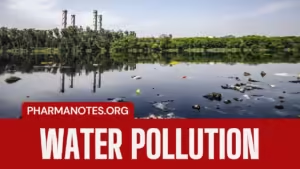Water pollution

Intended Learning Outcomes
At the end of this session, students will be able to
• Explain water Pollution
• Describe the source of water pollution
• Discuss the effect of water pollution
• Discuss control of water pollution
Water pollution
• Importance of water for sustenance of life cannot be overemphasized. Whether it is in use of running water in our homes, rearing cattle and growing crops in our farms, or the increased uses in industry, remain immeasurable
• It is important therefore, to not that depletion of this commodity either through contamination, or careless use results in serous consequences
• Water is considered polluted if some substances or condition is present to such a degree that the water cannot be used for a specific purpose
• Defined as presence of excessive amounts of a hazard (pollutants) in water in such a way that it is no long suitable for drinking, bathing, cooking or other uses
• Pollution is the introduction of a contamination into the environment
• It is created by industrial and commercial waster, agricultural practices, everyday human activities and most notably, models of transportation
Sources of Water Pollution
i. Sewage leakages
ii. High population density
iii. Oil spillage
iv. Industrial waste dumped into our waters
v. Pollution of ground water through drilling activities
vi. Flooding during rainy season which carries waste deposits into our waters
vii. Radioisotopes
viii. Heavy metal
ix. Combustion
x. Toxic waste disposal at sea
xi. Mineral processing plant (e.g. coal production)
xii. Eroded sediments xiii. Deforestation
xiv. Mining
xv. Pesticides
xvi. Herbicides and fertilizers xvii. Failing septic system
xviii. House hold chemicals
xix. Animal wastes
Effects of Water Pollution
• Water pollution has a duel effect on nature
• Has negative effects on the living and also on the environment
• Effects of pollution on human beings and aquatic communities are many and varied
• Water pollution causes approximately 14,000 deaths per day, mostly due to contamination of drinking water by untreated sewage in developing countries
• An estimated 700 million Indians have no access to a proper toilet and 1,000 Indians children’s die of diarrhea every day
• Biomas and diversity of communities are to be expected when large amount of toxic materials are released into the streams, lakes and coastal waters in the ocean
• Much of aquatic pollution involves sewage in which organic waste predominate
• This waste can increase secondary productivity while altering the character of the aquatic community
• Most fishes especially the species desired as food by man are among the sensitive species that disappear with the least intense pollution
• Water pollution leads to damage to human health
• Disease carrying agents such as bacteria and viruses are carried into the surface and ground water
• Drinking water is affected and health hazards result
• Direct damage to plants and animals nutrition also affects human health
• Plants nutrients including nitrogen, phosphorus and other substances that support the growth of aquatic plant life could be in excess causing algal gloom and excessive weed growth
• This makes water to have odour, taste and sometimes colour
• Ultimately, the ecological balance of a body of water is altered
• Sulphur dioxide and nitrogen oxides cause acid rain which lowers the PH value of soil and emission of carbon dioxide cause ocean acidification, the ongoing decrease in the PH of the Earth’s Oceans as CO2 becomes dissolved
Pollution Management and Control
• There are many approaches that could be adopted in water pollution control and management
• Prevention of water pollution includes the following ways:
i. Wash your car far away from any storm water drains
ii. Don’t throw trash, chemicals or solvents into sewer drains
iii. Inspects your septic system every 3 – 5 years
iv. Avoid using pesticides and fertilizers that can run off into water systems
v. Sweep your driveway instead of hosing it down
vi. Always pump your waste-holding tanks on your boat vii. Use non-toxic cleaning materials
viii. Clean up oil and other liquid spills with kitty litter and sweep them up
ix. Don’t wash paints brushes in the sink
Another way is to join or get involved with pollution prevention is to practice efforts on your own or join projects or programme
• Pollution control means to control the emissions and effluents into the air, water and land or soil
• Without pollution control, the waster products from consumptions, heating, agriculture, mining, manufacturing, transportation and other human activities, whether they accumulate or disperse, will degrade the environment
• Pollution prevention and waste minimization are more desirable than pollution control
• However, pollution could be minimize by adopting these practices
(i) by recycling
(ii) by reusing
(iii) waste minimization
(iv) by mitigating
(v) by preventing
(vi) by compost
Summary
• Water is considered polluted if some substances or condition is present to such a degree that the water cannot be used for a specific purpose
• Sources of Water Pollution are Sewage leakages, High population density, oil spillage etc
• Water pollution has a duel effect on nature and has negative effects on the living and also on the environment
• There are many approaches that could be adopted in water pollution control and management i.e. prevention, practice efforts or join a project/program; Regulation and monitoring or engaging in control measures by reducing or minimizing waste
Also, Visit:
B. Pharma Notes | B. Pharma Notes | Study material Bachelor of Pharmacy pdf